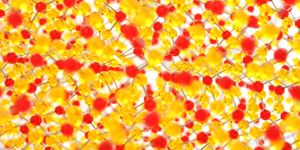Mechanisms Underlying Tourette Syndrome Revealed by Brain Organoids
Tourette syndrome (TS) is a nervous system disorder that causes sudden movements, twitches, or sounds that are repeated. The Centers for Disease Control and Prevention compares these 'tics' to hiccups; even when you want to stop, your body still does it. TS is typically diagnosed when people are between the ages of five and ten, and is often accompanied by attention deficit hyperactivity disorder (ADHD) or obsessive-compulsive disorder (OCD). Estimates vary, but as many as one in 50 children may have TS, and it may be underdiagnosed.
Research has shown that in TS, a region of the brain under the cerebral cortex called the basal ganglia is smaller and holds fewer cells called interneurons, which are crucial to regulating inhibition. The basal ganglia is related to language and specialized movements. In a new study reported in Molecular Psychiatry, researchers used cells from five TS patients and eleven unaffected individuals to generate organoids - simplified, three-dimensional models of organs. The organoid cells were genetically reprogrammed to represent the basal ganglia.
The researchers examined inhibitory interneurons in the TS and control organoids, looking for the locations of certain proteins, as well as performing RNA sequencing to identify the genes that were being expressed in the organoids. This work confirmed the deficit of inhibitory interneurons in TS patient basal ganglia.
The research also indicated that in TS patients, these interneurons are not dying off, they never form in the first place, said senior study author Flora Vaccarino, MD, the Harris Professor at the Yale Child Study Center. "Following the organoid from the very beginning of its development, we saw that these cells were just not there."
Progenitor cells give rise to other cell types. But the progenitors of inhibitory interneurons were creating different cells in TS organoids, leading to an abnormal neuron pattern compared to heathy organoids. Further work suggested that signaling in a pathway known as Sonic Hedgehog was abnormal in TS organoids, which probably led to the problems that were observed in basal ganglia development.
The researchers also found a link between the severity of disease and the extent of basal ganglia abnormalities. Of the five TS patients, one had much milder symptoms compared to the others, and the organoids that were generated from this patient also had the least evidence of abnormalities and interneuron loss. The study authors noted that it may be possible to predict the severity of a patient's disease by generating and analyzing organoids from their cells. This could help clinicians diagnose and treat the disorder at earlier times, noted first study author Melanie Brady, Ph.D.
Now the research team is interested in investigating the genetic and epigenetic factors that may lead to the issues observed in basal ganglia organoids from TS patients, and potential treatments.
"Once you find out why something is happening developmentally, then you can think of ways to make it better," added Vaccarino.
Sources: Yale University, Molecular Psychiatry









